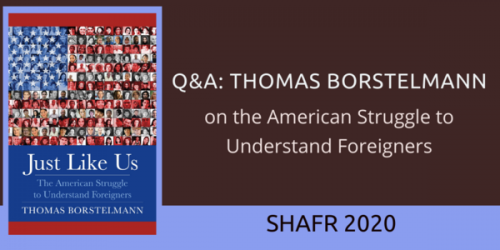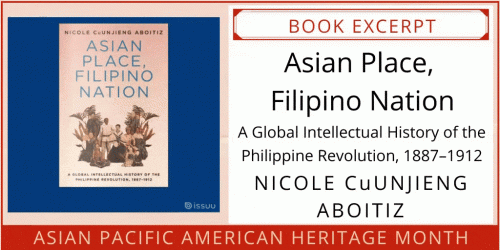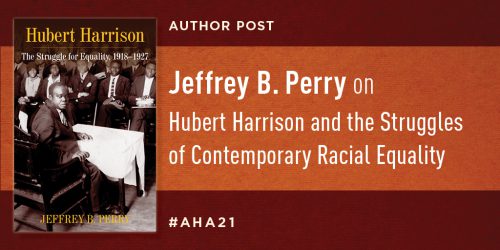Q&A: Nicole CuUnjieng Aboitiz on Asian Place, Filipino Nation

“In restoring the intellectual history of the Philippine Revolution, at long last, to its pan-Asian context, Nicole CuUnjieng Aboitiz offers a startling new perspective not only on the history of the Philippines in that era but on the evolution of anticolonial modernity in Asia writ large.”
—Erez Manela, Harvard University
Today’s AHA virtual book exhibit feature is a Q&A with Nicole CuUnjieng Aboitiz, author of Asian Place, Filipino Nation: A Global Intellectual History of the Philippine Revolution, 1887–1912—a work that reconnects the Philippine Revolution to the histories of Southeast and East Asia through an innovative consideration of its transnational political setting and regional intellectual foundations.
• • • • • •
Q: The subtitle says this is a global history, but it’s about the Philippine Revolution—–a very localized event. Can you speak to the global dimensions of this book?
Nicole CuUnjieng Aboitiz: The history of the Philippine Revolution has global implications, global considerations, and global roots, but it often operates within an immediately regional, rather than global, setting—though it always does so with an eye to the perceived distinction between East and West. My book attempts a global intellectual history of the Philippine Revolution methodologically rather than only through drawing a necessarily global scope to the revolution. I share the emergent global intellectual-historical field’s goal of enlarging the field of intellectual history beyond its canonical figures and texts, who and which have been traditionally located in the West. What separates this global approach from only being a recuperation of non-Western thought into intellectual history, however, is its broader methodological grounding in service of that aim.
This is also what distinguishes global intellectual history’s work from that of older area-studies models and civilizational units of analysis, which have long looked at canonical non-Western philosophers and thinkers, ranging from Confucius to Tagore. I employ global intellectual history as a method by acknowledging the need to adapt analytical tools in order to bring other or overlooked actors into the intellectual historical field. For example, I look at affective and material dimensions in order to recover the pan-Asianism of the “periphery” while seeking to make it legible to and included alongside our understandings of the pan-Asianism of the “center.” In this way, global intellectual-historical approaches draw from older subaltern historical fields’ methodological experimentation but also depart from those fields in aim, as the emergent global intellectual-historical field seeks to make more global—and even subaltern—forms of intellectual history legible to the prior, established intellectual historical field.
Q: You mention the connections to the wider Asia region. What was the long-term impact of the Philippine Revolution in Asia?
NC-A: The Philippine Revolution proved to be a turning point in Southeast Asia. Rather than simply failing to maintain a traditional state (as in Vietnam and Burma), or largely succeeding in maintaining one (as in Cambodia and Thailand), it was briefly successful in establishing the First Philippine Republic—a modern, secular, native republic in Asia. The revolution had wide reverberations in Southeast Asia, and we have politicians as late as the Indonesian president Sukarno referencing José Rizal and the Philippine Revolution as inspirations. Further afield, Rebecca Karl argues that for Chinese intellectuals Propagandist and revolutionary Mariano Ponce’s writings on the Philippine struggle “first persuasively cast colonialism as a global discursive problem, a characterization that not only facilitated the universalization of the Philippine national experience well beyond its particularities, but one that endured well beyond the duration of the Philippine situation itself.” Mai Menghua, a Chinese reformist and colleague of Liang Qichao, wrote an essay in 1897 praising the abstract values of the literary trope of the knight errant. Mai believed this spirit of the knight errant was essential to the nation. By 1900, however, Mai had linked this trope to the Philippine Revolution. Mai urged the Chinese people to recognize that the global knight errant figure was not merely an abstract trope, but was actively exemplified by peoples, such as the Filipinos, who had risen up, and was not exemplified by those who had failed to revolt, such as the Indians and potentially the Chinese.
This reinterpretation is fascinating for its blending of the Japanese shishi and the Filipino revolutionary figures with the literary trope of the knight errant, creating from this an altogether new, modern, national role out of the formerly merely heroic individual. Moreover, this figure was historicized and particularized, drawing upon specific examples from within the Asian geography of political affinity, and was also generalized as a ‘type’ to be embodied transnationally. In this process of fashioning a novel national, revolutionary, heroic type, the Filipino created new modes of sociopolitical practice for the colonized in the modern world. Guangdong intellectual Ou Jujia marked the Philippines, not Japan, as the Asian pioneer, being the first to actively defend independence for “Asia” in this era. It is interesting that, in this interpretation, the trope of Filipinos rising up for the Philippines is elided with a rising up for Asia more generally, assuming a broader Asian geography of political affinity and action. Indeed, this is what the Philippine revolutionaries themselves believed: that their revolution was part of a wider transnational anticolonial struggle and that they were leading brethren Malay nations toward a new future in Asia.
Q: You consider this a revisionist history. Why is that?
NC-A: My book is a revisionist intervention in the historiography of the most written-about subject in Philippine history: the foundational moment of the emergence of the nation, and it also seeks to correct the largely discursive and Northeast Asia–-centric literature on pan-Asianism. While my book seeks to return the Philippines to the Southeast Asian region from which it has been historiographically separated, I also see my book as connecting Philippine history and Southeast Asian history to broader literatures and inquiries. Global scholarship have recently borne out the ways in which anti-imperial and nationalist movements developed, not only through interaction between European colonial centers and their peripheries but also through interaction between peripheries. This insight built on the foundational scholarship on anticolonial nationalism that focused on global connections and transnational transmission of ideas in the disintegration of the Eurocentric order and emergence of what would become the Third World. I hope that my work can build on that.
In addition, I hope that my book may provide useful insight for studies of the history of the Global South as well as an interesting companion to some of global history’s debates about the rise of the nation-state and its teleologies. Southeast Asia bedevils a lot of the field’s assumptions about both the anti-teleological position regarding the nation-state, which focuses on the enduring perceived viability of political forms alternative to the nation-state, as well as the literature on the global convergence upon the nation-state form. This is just one of the many reasons why I believe Southeast Asia needs to be better represented in our narratives of global history and teaching of global history, not to mention our as yet emergent field of global intellectual history, which can be forgiven more in this, given we are still constructing it.
Save 20 percent on our conference titles on display when you use coupon code AHA at checkout form our website by March 1. 2021








